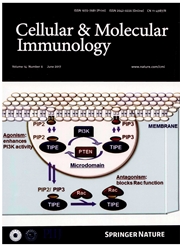

 中文摘要:
中文摘要:
Fas/FasL 系统播送细胞内部的 apoptotic 发信号,导致房间 apoptosis。然而,船边交货发信号也除了导致肿瘤房间 apoptosis 施加 non-apoptotic 功能。例如,船边交货发信号导致肺癌症肿瘤房间生产前列腺素 E2 (PGE2 ) 和成员导出 myeloid 的 suppressor 房间(MDSC ) 。激活的细胞毒素的 T 淋巴细胞(CTL ) 导致并且表示 FasL 在房间仍然是的 apoptosis 抵抗的肿瘤上在 CTL 开始的船边交货激活的 FasL,而是效果的高水平大部分不清楚。我们从 OT-1 老鼠净化了激活的 CD8 + T 房间,在肿瘤房间逃跑上评估了船边交货激活的规章的效果并且调查了相关机制。我们发现 CTL 导致了肿瘤细胞分泌 PGE2 和增加肿瘤经由船边交货发信号的 MDSC 的调停房间的 chemoattraction,它对肿瘤生长有利。我们的结果显示 CTL 可以参予肿瘤免疫者避免过程。就我们的知识而言,这是 CTL 在肿瘤逃跑由起一个作用的新奇机制。我们的调查结果含有经由对肿瘤的否定有免疫力的回答的减小提高 antitumor 免疫者反应的策略通过船边交货发信号由 CTL 支持了。
 英文摘要:
英文摘要:
The Fas/FasL system transmits intracellular apoptotic signaling, inducing cell apoptosis. However, Fas signaling also exerts non-apoptotic functions in addition to inducing tumor cell apoptosis. For example, Fas signaling induces lung cancer tumor cells to produce prostaglandin E2 (PGE2) and recruit myeloid-derived suppressor cells (MDSCs). Activated cytotoxic T lymphocytes (CTLs) induce and express high levels of FasL, but the effects of Fas activation initiated by FasL in CTLs on apoptosis-resistant tumor cells remain largely unclear. We purified activated CD8^+ T cells from OT-1 mice, evaluated the regulatory effects of Fas activation on tumor cell escape and investigated the relevant mechanisms. We found that CTLs induced tumor cells to secrete PGE2 and increase tumor cell-mediated chemoattraction of MDSCs via Fas signaling, which was favorable to tumor growth. Our results indicate that CTLs may participate in the tumor immune evasion process. To the best of our knowledge, this is a novel mechanism by which CTLs play a role in tumor escape. Our findings implicate a strategy to enhance the antitumor immune response via reduction of negative immune responses to tumors promoted by CTLs through Fas signaling.
 同期刊论文项目
同期刊论文项目
 同项目期刊论文
同项目期刊论文
 期刊信息
期刊信息
